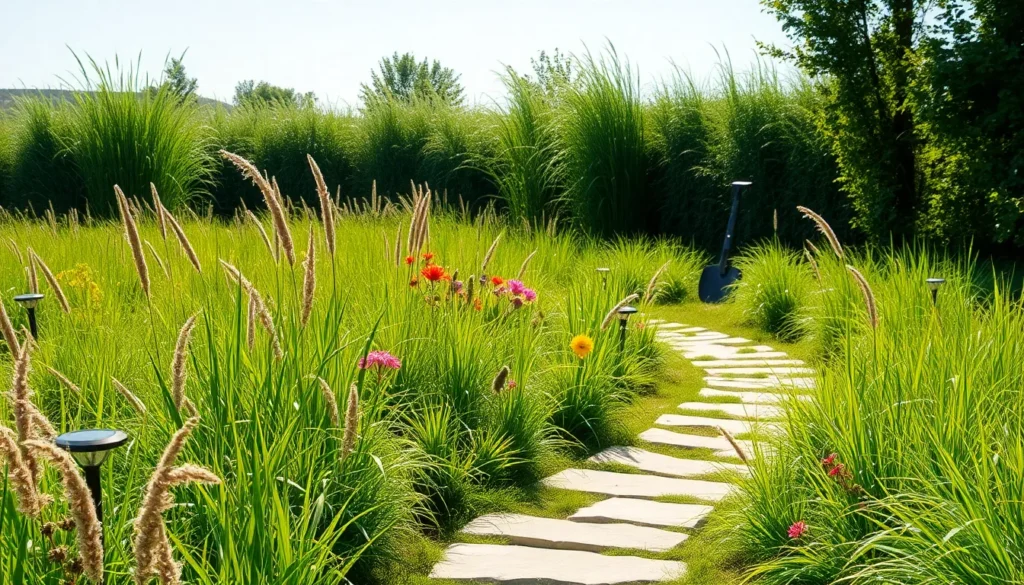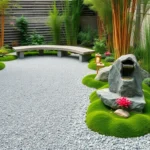We’ve all dreamed of having that picture-perfect lawn that makes our neighbors green with envy. But achieving a stunning grass garden doesn’t have to be complicated or expensive. With the right planning and creative approach you can transform any outdoor space into a lush green paradise that becomes the heart of your home’s curb appeal.
From choosing the perfect grass variety for your climate to incorporating eye-catching design elements we’ll show you how to create a garden that’s both beautiful and functional. Whether you’re working with a small urban plot or sprawling suburban yard there are countless ways to make your grass garden stand out.
The secret lies in understanding what works best for your exact conditions and lifestyle. We’re here to guide you through proven strategies that’ll help you achieve the vibrant healthy lawn you’ve always wanted while adding unique touches that reflect your personal style.
Create a Traditional Lawn Garden With Native Grass Varieties
Building on the foundation of thoughtful planning, we can achieve stunning results by selecting grass varieties that naturally thrive in our local environment. Native grasses offer superior resilience and require minimal maintenance once established.
Choose Climate-Appropriate Grass Species
Cool-season grasses perform best in northern regions where temperatures stay moderate during growing seasons. Tall fescue adapts to various soil conditions and tolerates foot traffic exceptionally well. Fine fescue varieties like chewing fescue and red fescue create dense carpets in shaded areas where other grasses struggle.
Warm-season options flourish in southern climates with hot summers and mild winters. Bermuda grass spreads rapidly through runners and recovers quickly from damage. Zoysia grass forms thick, luxurious lawns that feel soft underfoot and resist weeds naturally. Buffalo grass native to prairie regions requires minimal water and stays green longer during drought periods.
Transitional zones benefit from carefully selected varieties that handle temperature fluctuations. Kentucky bluegrass mixed with perennial ryegrass creates durable lawns that stay attractive year-round. We recommend consulting local extension offices to identify grass species that perform optimally in your exact hardiness zone.
Establish Proper Soil Preparation Techniques
Soil testing reveals pH levels and nutrient deficiencies that affect grass establishment success. Most grass varieties prefer soil pH between 6.0 and 7.0 for optimal nutrient uptake. We add lime to raise pH in acidic soils or sulfur to lower pH in alkaline conditions based on test results.
Organic matter incorporation improves soil structure and water retention significantly. Compost mixed into the top 6 inches creates ideal growing conditions for grass roots. Aged manure or leaf mold works equally well for enriching clay or sandy soils that lack nutrients.
Proper grading ensures water drains away from structures while preventing pooling in low areas. We create gentle slopes of 1 to 2 percent to direct water flow effectively. Compacted soil areas require mechanical aeration or tilling to allow root penetration and air circulation.
Carry out Sustainable Watering Practices
Deep, infrequent watering encourages robust root development compared to frequent shallow applications. We water grass 1 to 1.5 inches per week including rainfall to maintain healthy growth. Morning watering between 6 AM and 10 AM reduces evaporation losses and prevents disease issues.
Smart irrigation systems monitor soil moisture levels and weather conditions automatically. Drip irrigation zones target exact grass areas without wasting water on walkways or driveways. Rain sensors prevent unnecessary watering during natural precipitation events.
Drought-resistant strategies help maintain grass health during water restrictions or dry periods. We raise mowing height to 3 inches or higher to shade soil and reduce moisture loss. Mulching mowers return grass clippings to the lawn as natural fertilizer and moisture retention.
Design a Low-Maintenance Ornamental Grass Garden
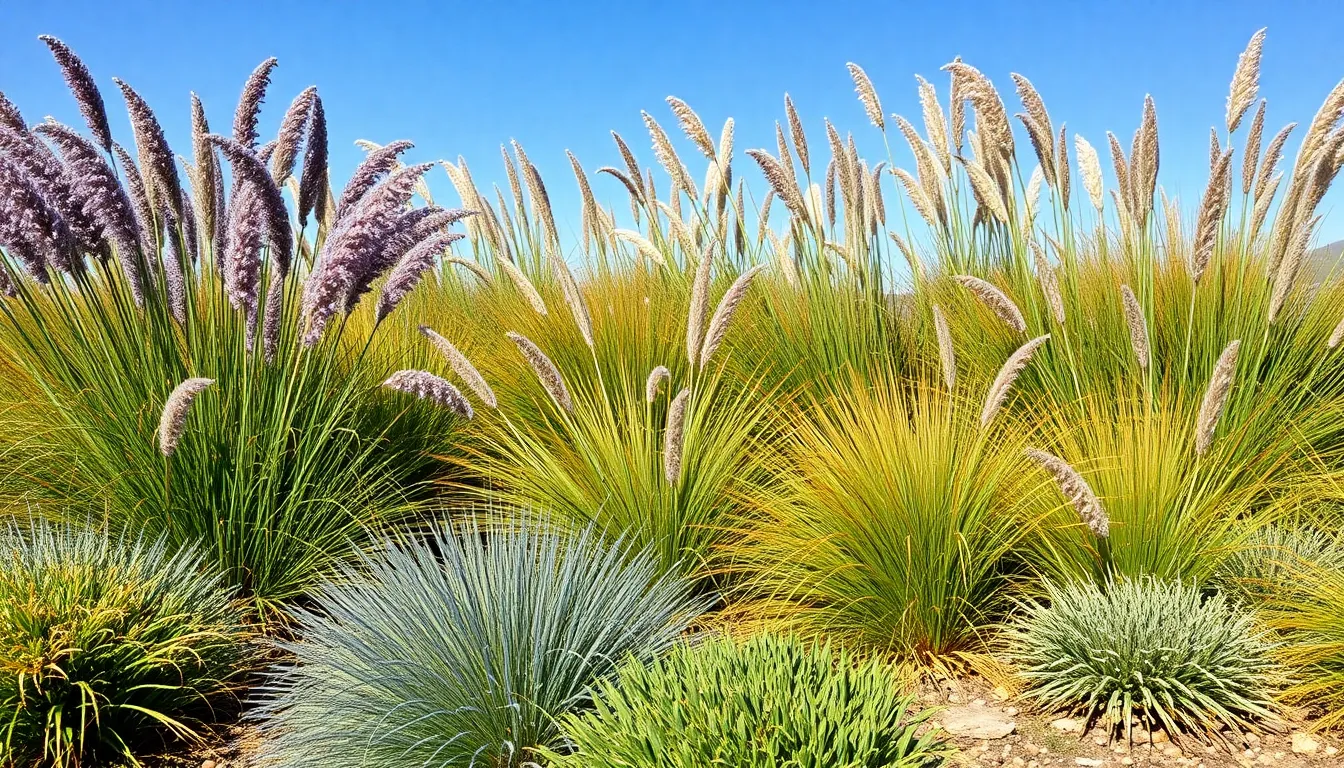
Creating an ornamental grass garden eliminates the need for constant upkeep while delivering stunning visual impact year round. Smart selection and strategic placement transform any industry into a ever-changing display that requires minimal intervention.
Select Drought-Tolerant Ornamental Grasses
Choosing resilient grass varieties forms the foundation of our low maintenance approach. Blue Oat Grass stands out as a top performer, earning recognition for its unique texture and minimal care requirements that make it a gardener favorite. Native options like Little Bluestem thrive naturally in full sun to partial shade conditions while tolerating well-drained soils without supplemental watering.
Evergreen selections such as Lomandra provide year-round structure and versatility in garden designs. These hardy grasses adapt to various soil conditions and climate zones, reducing our need for ongoing soil amendments or special care routines. We can rely on their natural drought tolerance to maintain healthy growth even during dry spells.
Plan Seasonal Color Combinations
Strategic color planning ensures our grass garden remains vibrant throughout every season. Spring welcomes us with fresh green foliage that signals new growth and renewed energy in the industry. Summer months showcase grasses that maintain their vibrant colors even though heat stress and reduced rainfall.
Fall transforms our garden as grasses like Little Bluestem shift to stunning copper and gold hues that rival traditional autumn displays. Winter interest comes from evergreen varieties such as Lomandra that preserve their color and structure when other plants go dormant. This four-season approach eliminates gaps in visual appeal while requiring no seasonal replanting.
Arrange Grasses by Height and Texture
Layering grasses creates depth and movement that enhances the overall garden composition. Short grasses work perfectly as borders or ground cover elements that define pathways and garden edges. Medium height varieties occupy the middle tier, providing texture and gentle movement that adds life to static landscapes.
Tall grasses command attention at the back of plantings, creating dramatic height and visual depth that draws the eye upward. Combining fine, medium, and coarse textures throughout our design adds visual interest without requiring complex maintenance schedules. We cut back all grasses in early spring to maintain their shape and promote vigorous new growth for the coming season.
Build a Contemporary Grass Pathway Design
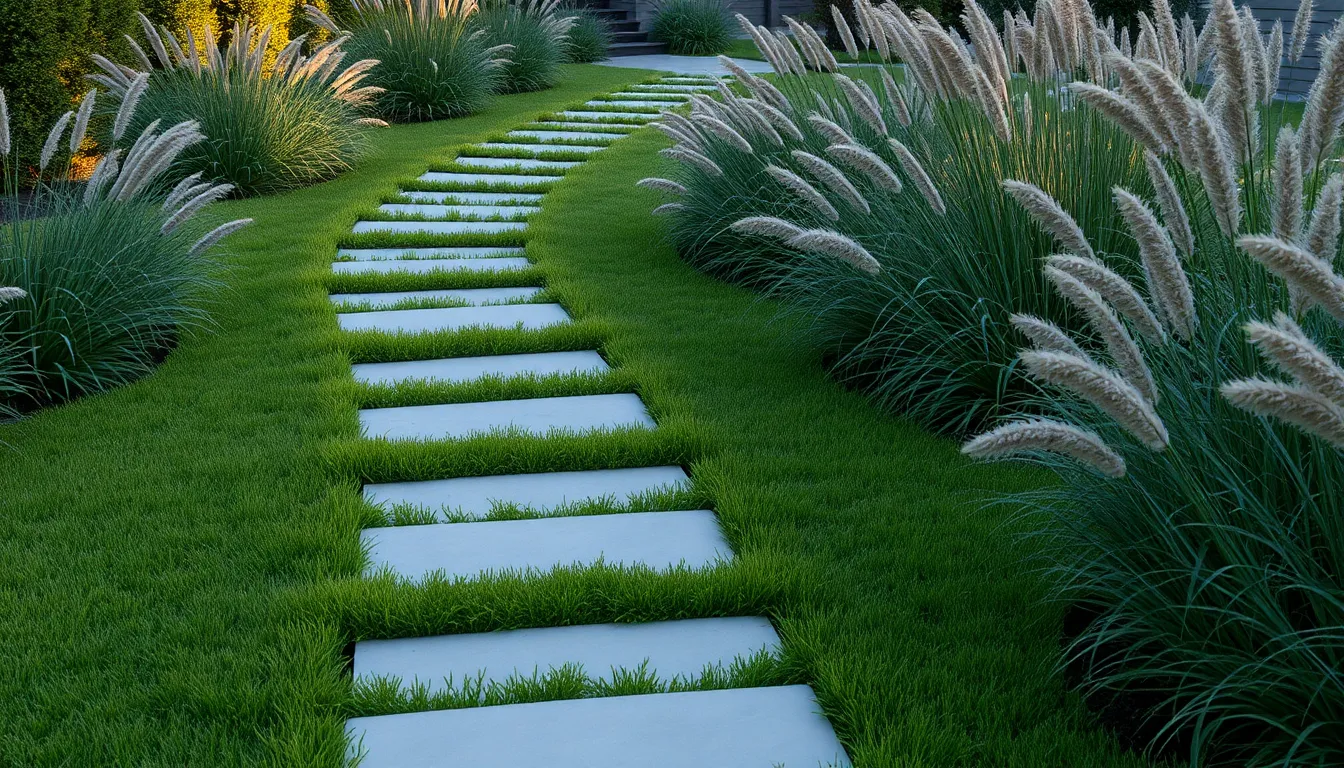
Contemporary grass pathways elevate your outdoor space with clean lines and natural beauty that complements modern landscaping trends. We can create stunning visual impact by designing mown grass paths that cut through larger lawn areas while maintaining cost effectiveness and sophisticated appeal.
Install Stepping Stone Walkways Through Tall Grasses
Stepping stones create elegant pathways that guide visitors through ornamental grass gardens with natural organic flow. We recommend positioning stones in staggered patterns to enhance visual interest while providing clear navigation through dense plantings. Natural stone materials like flagstone or concrete pavers work exceptionally well when placed 18-24 inches apart to accommodate comfortable walking strides.
Tall grasses like fountain grass or pampas grass frame stepping stone pathways beautifully while adding movement and texture to the design. We suggest choosing stones that contrast with surrounding grass colors to create defined visual boundaries. Irregular shaped stones offer a more organic appearance while rectangular pavers provide contemporary geometric lines that align with modern design principles.
Create Defined Borders With Edging Materials
Edging materials establish clear boundaries that maintain organized appearances while preventing grass from spreading into unwanted areas. We can use brick, natural stone, or composite wood materials to create sharp lines that separate different garden sections effectively. Metal edging strips offer sleek contemporary looks while requiring minimal maintenance over time.
Professional installation ensures borders remain level and stable throughout seasonal changes that affect soil movement. We recommend installing edging 2-3 inches deep to provide adequate root barriers while maintaining visual appeal. Curved borders soften harsh lines in contemporary designs while straight edges emphasize geometric patterns that complement modern architecture.
Incorporate Lighting for Evening Appeal
Lighting transforms grass pathways into stunning evening features that extend outdoor enjoyment beyond daylight hours. We can install solar powered pathway lights along borders to create gentle illumination that highlights grass textures and pathway directions. LED strip lighting hidden beneath edging materials provides subtle ground level glow that enhances safety without overwhelming natural beauty.
String lights suspended above pathways create magical overhead ambiance that draws people through garden spaces during evening gatherings. We suggest using warm white LED bulbs rather than cool white options to maintain cozy atmospheric appeal. Timer controlled systems automatically illuminate pathways at dusk while conserving energy throughout the night hours.
Establish a Prairie-Style Grass Meadow Garden
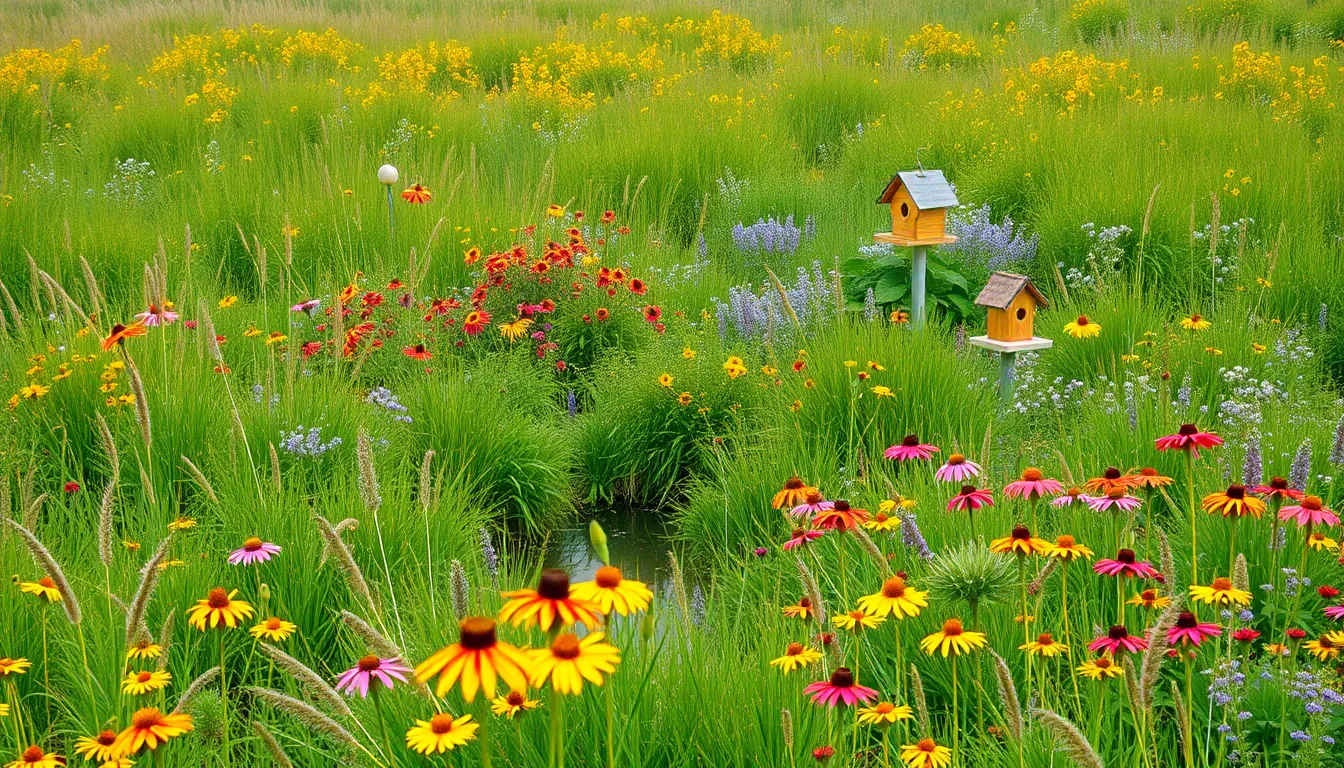
Creating a prairie-style grass garden transforms your outdoor space into a stunning natural industry that celebrates native plants. We’ll help you build an authentic meadow that combines beauty with ecological benefits.
Combine Native Grasses With Wildflowers
Native grasses like little bluestem, big bluestem, and Indian grass form the foundation of our prairie meadow design. These species naturally thrive in prairie landscapes and require minimal maintenance once established. Wildflowers such as coneflowers, black-eyed Susans, and cosmos add vibrant color while attracting essential pollinators to our garden.
Balancing our plant selection creates visual harmony throughout the growing season. We recommend using a 60% grasses to 40% wildflowers ratio for optimal results, though we can adjust these proportions based on local conditions and personal preferences. Strategic grouping of plants in rhythmic patterns enhances the overall visual appeal of our meadow garden.
Plan for Natural Wildlife Habitat Creation
Biodiversity flourishes when we incorporate plants that provide food, shelter, and nesting sites for local wildlife. Mixed plantings create layers of habitat that support everything from beneficial insects to songbirds throughout the year. Water features like small ponds or birdbaths attract additional species and serve as essential resources during dry periods.
Focal points such as birdhouses or trellises enhance both visual appeal and wildlife support in our prairie garden. Varying bloom times and plant textures maintain year-round interest while providing continuous resources for different species. Native plant combinations naturally support local ecosystems better than non-native alternatives.
Manage Growth Through Selective Cutting
Regular trimming maintains a balanced appearance and prevents any single species from dominating our prairie meadow. Selective cutting allows us to shape growth patterns while preserving the natural character of the industry. Timing our maintenance activities around wildlife needs ensures we don’t disrupt nesting or feeding cycles.
Strategic removal of spent blooms extends flowering periods and encourages continued growth. We focus on maintaining clear sight lines and pathways while allowing the majority of our meadow to grow naturally. Winter cutting back prepares our grasses for vigorous spring growth and maintains the garden’s overall health.
Construct Raised Grass Garden Beds
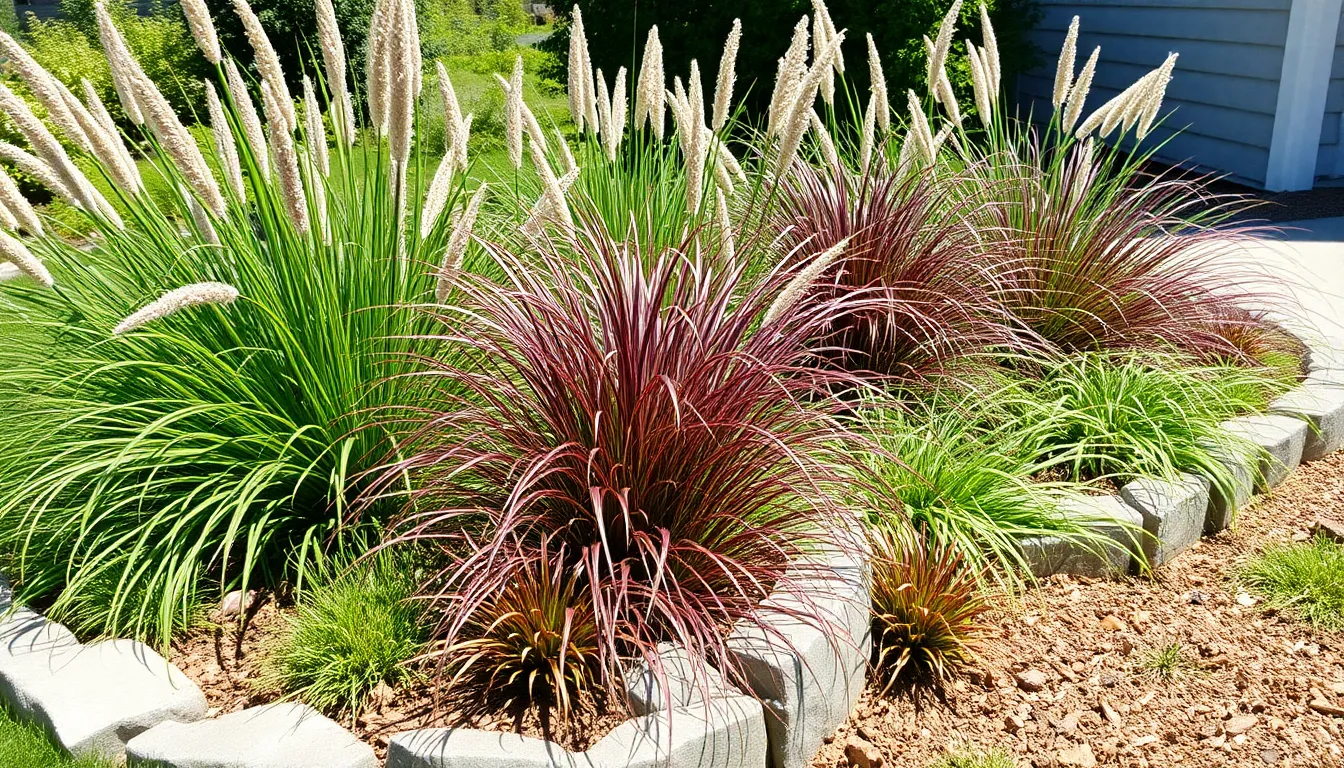
Raised garden beds transform your grass garden into a structured showcase that promotes healthier plant growth and easier maintenance. We’ll enhance drainage and soil quality while creating prominent grass borders that define your outdoor space.
Build Elevated Planters for Better Drainage
Elevated planters offer superior drainage control for your ornamental grasses. These containers prevent waterlogging issues that commonly plague ground-level plantings. We recommend choosing planters with adequate drainage holes to ensure proper water flow.
Container gardens provide exceptional flexibility in your grass garden design. You can relocate these portable displays seasonally or rearrange them for special occasions. This method works particularly well in areas with poor native soil conditions.
Small spaces benefit tremendously from elevated planter answers. Patios, decks, and balconies can incorporate stunning grass elements through strategic container placement. We’ve found this approach especially valuable for urban gardeners with limited ground space.
Layer Different Grass Heights for Visual Interest
Layering creates ever-changing texture and natural movement throughout your grass garden. Position taller varieties like Miscanthus or switchgrass (Panicum virgatum) at the back of your raised beds. This backdrop establishes the foundation for your layered design.
Medium height grasses form the transitional middle section of your arrangement. These varieties bridge the gap between your tallest specimens and foreground plantings. We suggest selecting grasses that complement both height extremes in color and texture.
Low growing clumping grasses complete your foreground display beautifully. These shorter varieties provide detailed interest for close viewing while maintaining the overall composition. This strategic approach maximizes visual appeal across all seasons.
Add Mulch and Stone Accents
Mulch application retains essential soil moisture while suppressing unwanted weeds. We apply a 2-3 inch layer around grass plantings to maintain consistent growing conditions. This practice significantly benefits ornamental grass health and reduces maintenance requirements.
Stone edging defines your garden areas with clean, professional boundaries. Natural materials like river rocks or decorative gravel provide striking contrast against grass foliage. We recommend selecting stones that complement your home’s architectural style.
Accent placement enhances both formal and relaxed garden designs. Strategic stone positioning creates focal points while preventing grass spread beyond designated areas. This combination of mulch and stone elements establishes a polished, cohesive appearance that showcases your raised grass beds effectively.
Develop a Zen-Inspired Grass Garden Space
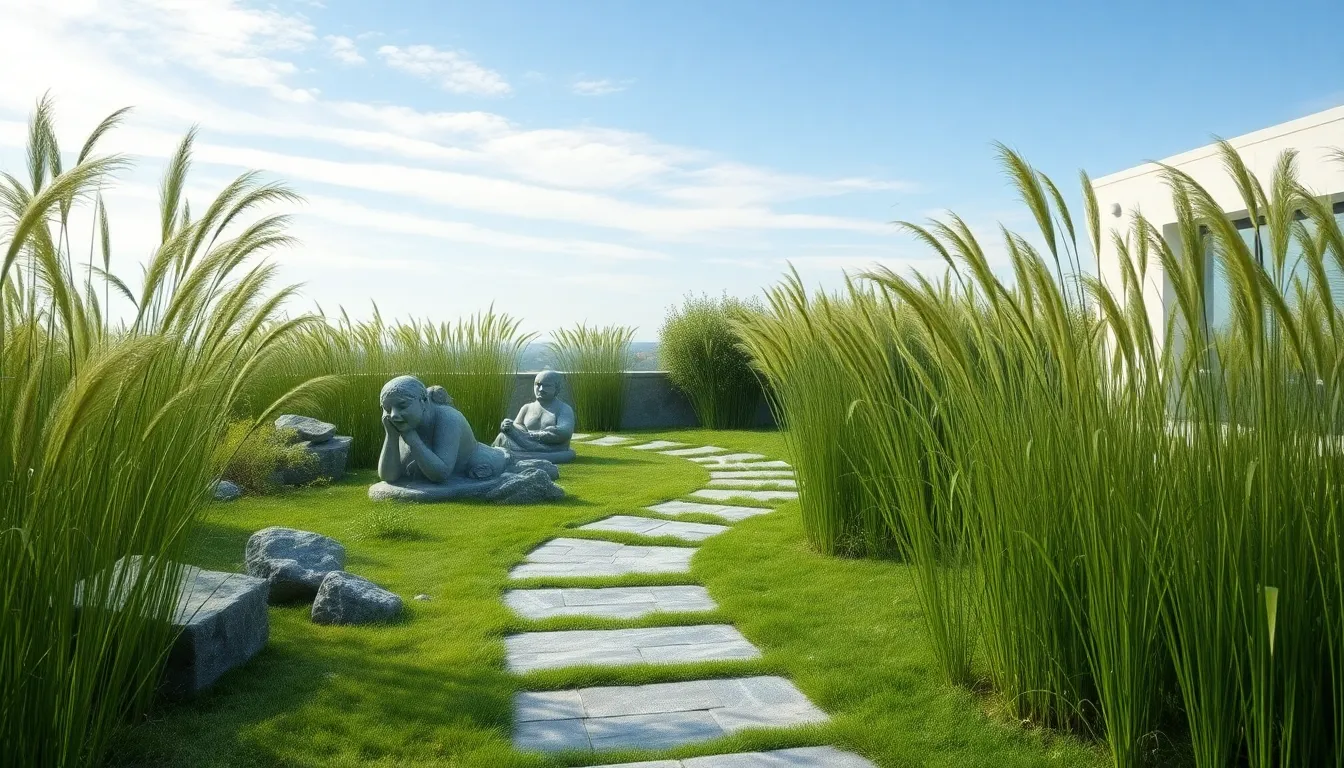
Transform your outdoor space into a peaceful retreat by incorporating grass elements that enhance the traditional Zen garden concept. Modern interpretations of Zen design can beautifully blend natural grass textures with meditative elements to create a harmonious sanctuary.
Use Fountain Grass for Peaceful Movement
Fountain grass serves as an exceptional focal point that brings gentle motion to your Zen-inspired space. Position these flowing, feathery plumes strategically around stone benches or sculptural elements to draw the eye naturally through your garden. Wind creates mesmerizing movement as the grass sways, producing a soothing visual rhythm that promotes relaxation and mindfulness. We recommend planting fountain grass in clusters rather than single specimens to amplify this calming effect.
Create Symmetrical Planting Patterns
Geometric grass arrangements offer a modern twist on traditional asymmetrical Zen principles while maintaining garden harmony. Plant grass in structured patterns to establish visual order and balance throughout your space. Contrast these symmetrical grass formations with naturally placed rocks or trees to achieve the perfect blend of contemporary design and organic elements. We suggest using fine-textured, low-growing grasses to create clean lines that won’t overwhelm other garden features.
Integrate Natural Stone Elements
Natural stone additions provide the essential foundation for any successful Zen grass garden design. Install stone pathways that guide visitors through your grass areas, creating a contemplative journey that encourages slow, mindful walking. Incorporate stone borders to define grass sections while adding textural contrast against the soft, flowing grass blades. We find that combining stone benches, lanterns, or sculptures with your grass plantings elevates the garden’s meditative atmosphere significantly. Position these stone elements to complement your grass ground cover, which can replace traditional gravel or sand while maintaining the peaceful, uncluttered aesthetic essential to Zen garden philosophy.
Install a Rooftop or Container Grass Garden
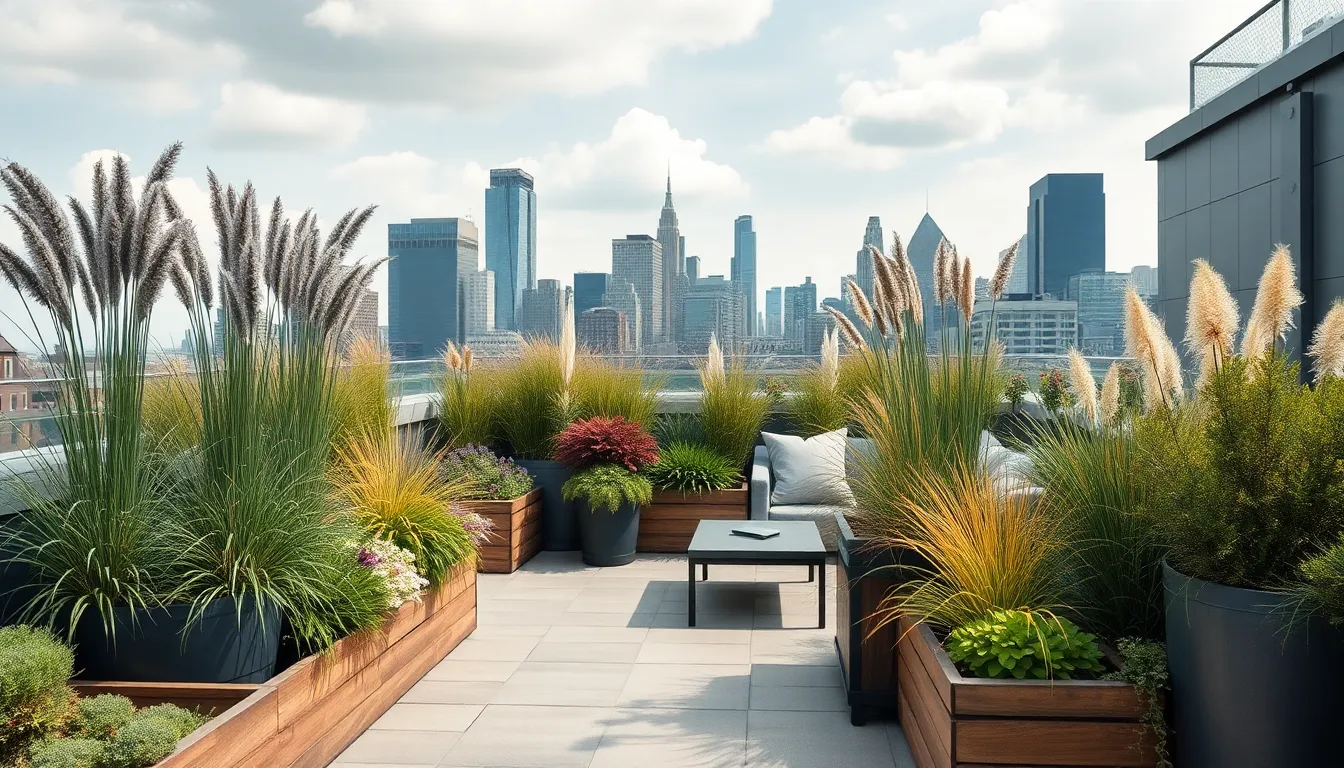
Container gardening transforms limited spaces into stunning grass gardens that bring natural beauty to urban environments. We’ll show you how to create thriving rooftop and container grass displays that enhance your outdoor living areas.
Select Compact Grass Varieties for Containers
Leymus arenarius (Blue Lyme Grass) forms attractive 2 to 3 feet tall tufts that work perfectly in containers. This variety offers stunning blue-green foliage and attracts butterflies while staying contained without spreading across garden beds. We recommend choosing this grass for its manageable size and visual appeal.
Compact ornamental grasses prevent invasive growth patterns that can overwhelm container gardens. Look for varieties specifically labeled as clumping rather than spreading types. These grasses maintain their shape while providing texture and color throughout the seasons.
Container friendly varieties typically mature at smaller sizes than their ground planted counterparts. Choose grasses that won’t outgrow their planters within the first growing season. We suggest researching mature heights before purchasing to ensure long term success.
Ensure Proper Drainage and Wind Protection
Well draining potting mixes prevent waterlogged soil conditions that can kill ornamental grasses. Use commercial potting blends designed for containers rather than garden soil. Add perlite or coarse sand to improve drainage if your mix seems too dense.
Wind protection becomes crucial for rooftop installations where gusts can damage grass blades and dry out containers quickly. Position planters near walls, railings, or other structures that provide natural windbreaks. We recommend grouping containers together to create mutual protection.
Sheltered locations help grasses survive harsh weather conditions while maintaining their attractive appearance. Avoid placing containers in areas that receive constant wind exposure. Move portable planters to protected spots during severe weather events.
Choose Weather-Resistant Planters
Durable materials like wood, metal, or high quality plastic withstand outdoor conditions year round. Avoid cheap plastic containers that crack in freezing temperatures or fade under intense sunlight. We prefer materials that complement your outdoor design while providing long lasting performance.
Proper sizing accommodates mature grass root systems and prevents frequent repotting. Select planters that are large enough for your chosen grass variety to reach full size. Remember that ornamental grasses grown in containers typically lose about two hardiness zones of cold tolerance.
Drainage holes must be adequate to prevent water accumulation that leads to root rot. Drill additional holes if your chosen planter doesn’t have sufficient drainage. We suggest placing containers on pot feet or blocks to improve airflow underneath and prevent water from pooling.
Conclusion
Creating your dream grass garden doesn’t have to be overwhelming when you break it down into manageable steps. We’ve shown you how proper planning and creativity can transform any outdoor space into a stunning industry that reflects your personal style.
Whether you’re drawn to low-maintenance ornamental grasses or prefer the ecological benefits of a prairie meadow we’ve covered options for every preference and climate. From rooftop containers to raised beds the possibilities are truly endless.
Remember that success comes from choosing the right grass varieties for your exact conditions and following proper care techniques. With these proven strategies you’re well-equipped to create a beautiful grass garden that’ll be the envy of your neighborhood while supporting local wildlife and improving your outdoor living experience.
Frequently Asked Questions
What are the best grass varieties for different climate zones?
Cool-season grasses like fescue and bluegrass thrive in northern regions with cold winters. Warm-season varieties such as Bermuda and Zoysia work best in southern climates. For transitional zones with temperature fluctuations, choose adaptable varieties or consider native grasses that naturally thrive in your local environment with minimal maintenance requirements.
How do I properly prepare soil for a new lawn?
Start by testing your soil’s pH levels and nutrient content. Incorporate organic matter like compost to improve soil structure and fertility. Ensure proper grading for effective water drainage, removing rocks and debris. Most grasses prefer slightly acidic to neutral soil (pH 6.0-7.0) for optimal growth and nutrient absorption.
What are the best watering practices for maintaining a healthy lawn?
Practice deep, infrequent watering rather than shallow daily sessions. This encourages deeper root growth and drought tolerance. Water early morning to reduce evaporation and disease risk. Consider installing smart irrigation systems to optimize water usage and ensure consistent moisture levels while conserving water resources.
How can I create a low-maintenance ornamental grass garden?
Select drought-tolerant varieties like Blue Oat Grass and Little Bluestem that require minimal care. Plan for seasonal color combinations to maintain year-round interest. Arrange grasses by height and texture, creating layers with short grasses in front and taller varieties in back for visual depth and movement.
What makes a prairie-style grass meadow garden beneficial?
Prairie meadows support local ecosystems by attracting pollinators and providing wildlife habitat. Combine native grasses like bluestem with wildflowers such as coneflowers and black-eyed Susans. These gardens require less water and maintenance while creating biodiversity and offering natural beauty that changes throughout the seasons.
How do I design effective grass pathways in my garden?
Install stepping stones through tall grasses using staggered patterns for visual interest. Use contrasting materials like natural stone for defined boundaries. Add edging materials such as brick or metal to prevent grass spread and create organized appearances. Consider the pathway’s width and flow for comfortable navigation.
What lighting options work best for grass pathways?
Solar-powered lights offer energy-efficient illumination without wiring requirements. Choose warm white LED bulbs to create a cozy, inviting atmosphere. Install timer-controlled systems for automatic operation and energy conservation. Position lights strategically to highlight pathway edges and key design features while ensuring safe navigation after dark.
Can I grow grass gardens in containers or on rooftops?
Yes, select compact varieties like Blue Lyme Grass that adapt well to container growing. Use weather-resistant planters with adequate drainage holes. Ensure proper sizing to accommodate root growth and provide wind protection for rooftop installations. Regular watering and fertilizing are essential due to limited soil volume in containers.
How do I create a Zen-inspired grass garden?
Use fountain grass planted in clusters for gentle movement and calming effects. Create symmetrical planting patterns for visual order and tranquility. Integrate natural stone elements like pathways and borders to guide movement through the space. Focus on creating balance between grass textures and meditative elements for a peaceful retreat atmosphere.
When and how should I maintain ornamental grasses?
Cut back all grasses in early spring before new growth begins to promote vigorous development. Remove dead foliage and seed heads unless you want winter interest. Most ornamental grasses require minimal fertilization and pruning. Divide clumping varieties every 3-4 years to maintain health and prevent overcrowding in garden beds.

